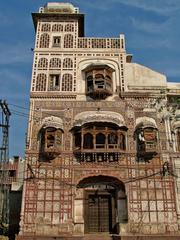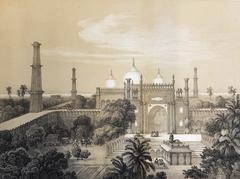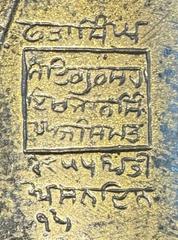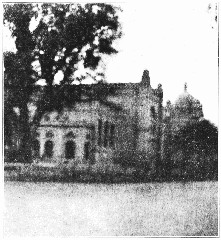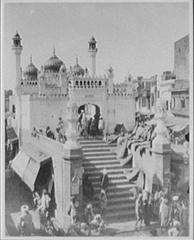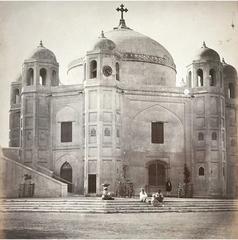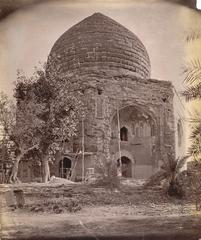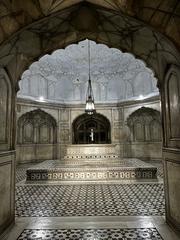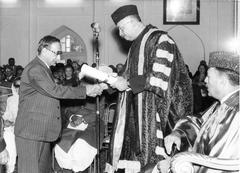Visiting the Well of Dina Nath Lahore: Visiting Hours, Tickets, and Historical Significance
Date: 14/06/2025
Introduction
Nestled within the storied Walled City of Lahore, the Well of Dina Nath—locally known as “Dina Nath ka Khoo”—stands as a remarkable testament to the city’s rich historical, architectural, and cultural heritage. Commissioned in the mid-19th century by Raja Dina Nath, an influential Sikh-era noble and finance minister under Maharaja Ranjit Singh, the well represents both a vital public utility and a symbol of Lahore’s pluralistic past. Its unique walled design, strategic location, and layered legacy make it a must-visit for history enthusiasts and casual travelers alike (Walled City of Lahore Authority, Guide to Pakistan, Dawn News).
Table of Contents
- Origins and Patronage
- Architectural Features
- Historical and Cultural Context
- The Legend of the Well
- Raja Dina Nath’s Legacy
- Visitor Information
- Conservation and Restoration
- Tips for Visitors
- Nearby Attractions
- FAQs
- Conclusion
- References
Origins and Patronage
The Well of Dina Nath was commissioned around 1849, at a pivotal time when Lahore was transitioning from Sikh to British rule. Raja Dina Nath, a Hindu in service to the Sikh court, envisioned the well as a philanthropic gesture to address the city’s growing water needs. Situated near Delhi Gate and Wazir Khan Mosque, the well’s placement was both practical and symbolically significant, intended to serve the diverse communities residing within the Walled City (Walled City of Lahore Authority, Dawn News, Punjab Gazetteer).
Architectural Features
Unlike typical open wells, the Well of Dina Nath is enclosed within a solid brick masonry structure topped with a dome, blending Sikh and Mughal architectural influences. The well’s circular chamber measures approximately 12 feet in diameter, and its dome and arched openings reflect the aesthetics of 19th-century Lahore. Durable baked bricks, lime mortar, and subtle decorative touches—such as lime plaster finishes—demonstrate the craftsmanship of local artisans. The structure’s design, resembling a small mausoleum, sets it apart from other urban wells (Guide to Pakistan, Traveling.com.pk).
Historical and Cultural Context
Sikh Era and Urban Transformation
During Maharaja Ranjit Singh’s rule, Lahore underwent modernization and expansion. The construction of the well near a major city entrance and mosque highlights its importance in daily life and urban planning. The site also reflects the Sikh administration’s commitment to civic amenities and interfaith coexistence (The Friday Times).
Community Symbolism
Used by Muslims, Sikhs, and Hindus alike, the well was central to communal gatherings, religious rituals, and festivals. Its presence near the Wazir Khan Mosque fostered both collaboration and, at times, controversy—particularly regarding its proximity to the original well of Sufi saint Said Soaf (Heritage Times).
The Legend of the Well
According to local legend, Raja Dina Nath’s decision to build the well near the saint’s original well met with resistance. It is said the well diggers reached depths of up to 200 meters but never struck water, a story interpreted as a cautionary tale about spiritual boundaries and humility. Despite its lack of water, the structure became a symbolic monument and a focal point for city legends (Wikiwand, Away With The Steiners).
Raja Dina Nath’s Legacy
Raja Dina Nath, originally from a Kashmiri Pandit family, rose to prominence in the Sikh Empire and was renowned for his administrative acumen and philanthropy. Aside from the well, his legacy includes the Haveli Dina Nath, a grand residence reflecting Lahore’s multicultural history (TripJive). His inclusive vision is embodied in the well’s role as a communal asset.
Visitor Information
Visiting Hours and Entry
- Hours: Daily, 9:00 AM – 6:00 PM (some sources mention 8:00 AM – 6:00 PM; check locally for updates)
- Entry Fee: Free; donations for preservation are welcomed but not required.
- Guided Tours: Available through the Walled City of Lahore Authority and local tour operators. Booking in advance is recommended, especially for groups (Walled City of Lahore Authority).
Accessibility
The well is located at Wazir Khan Chowk, near Delhi Gate, accessible on foot or via rickshaw. Restoration efforts have improved accessibility, but some uneven surfaces remain. Wheelchair users may require assistance.
Visitor Guidelines
- Dress modestly, as the well is adjacent to a mosque.
- Respect prayer times and ongoing community activities.
- Photography is allowed; drone usage may require special permission.
- Avoid littering and touching delicate architectural features.
Conservation and Restoration
The well and its surroundings have been restored by the Walled City of Lahore Authority and the Aga Khan Trust for Culture, with support from organizations such as PEPAC and the United States Ambassadors Fund for Cultural Preservation. Restoration efforts included removing encroachments, stabilizing the structure, and using digital documentation for accurate preservation. These initiatives have revitalized the square and enhanced the site’s educational and cultural value (Traveling.com.pk, Walled City of Lahore Authority).
Tips for Visitors
- Best Time: Early morning or late afternoon for pleasant weather and good lighting.
- Local Etiquette: Support local artisans by shopping at nearby craft stalls.
- Mobility: Plan ahead if you have mobility challenges due to cobbled streets.
- Virtual Tours: Interactive maps and virtual tours are available on the WCLA website, enhancing the visitor experience (WCLA Projects).
Nearby Attractions
- Wazir Khan Mosque: A masterpiece of Mughal architecture.
- Delhi Gate: Historic gateway to the old city.
- Shahi Hammam: Restored Mughal-era bathhouse.
- Bazaar Wazir Khan: Bustling market for local crafts.
- Haveli Dina Nath: A heritage mansion reflecting Sikh-Hindu design.
- Lahore Fort and Badshahi Mosque: Major historical complexes a short ride away.
These sites can be explored individually or as part of heritage walking tours (TripAdvisor, Trek Zone).
Frequently Asked Questions (FAQ)
Q: What are the visiting hours?
A: The well is generally open from 9:00 AM to 6:00 PM daily.
Q: Is there an entry fee?
A: No, entry is free.
Q: How do I get there?
A: The well is accessible from Delhi Gate and located at Wazir Khan Chowk. Use rickshaw, taxi, or walk from nearby landmarks.
Q: Are guided tours available?
A: Yes, through the Walled City of Lahore Authority and local operators.
Q: Is the site wheelchair accessible?
A: The area has uneven, cobbled surfaces; assistance is recommended for those with mobility issues.
Q: Is photography allowed?
A: Yes, but respect any posted restrictions.
Conclusion
The Well of Dina Nath stands as a unique symbol of Lahore’s architectural ingenuity, cultural pluralism, and layered urban history. Its walled structure, historical associations, and revitalization efforts make it a compelling stop on any heritage tour of the Walled City. Visitors can immerse themselves in the stories, legends, and vibrant community life that surround this remarkable site.
To maximize your visit, consider joining a guided tour, exploring nearby attractions, and supporting local conservation efforts. For up-to-date information, virtual tours, and travel tips, download the Audiala app and follow heritage channels for the latest on Lahore’s historical landscape. By visiting, you contribute to the ongoing preservation and celebration of one of South Asia’s most storied cities.
References
- Well of Dina Nath Visiting Hours, Tickets, and Historical Guide to Lahore’s Iconic Monument, 2023, Walled City of Lahore Authority
- Well of Dina Nath: Visiting Hours, Tickets & Exploring Lahore’s Historic Landmark, 2024, Guide to Pakistan
- Exploring the Well of Dina Nath: History, Legends, and Visiting Information in Lahore’s Walled City, 2023, Wikiwand
- Visiting Dina Nath’s Well in Lahore: Hours, Tickets, History, and Tips, 2024, Walled City of Lahore Authority
- Traveling.com.pk, The Hidden Gem of Lahore’s Walled City, 2024
- Dawn News, 2019, Historical Accounts of Lahore’s Sikh Era Infrastructure
- TripAdvisor, Well of Dina Nath Reviews and Visitor Information
